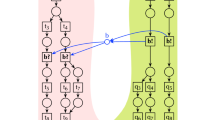Abstract
The analysis of time-varying systems is attracting a lot of attention in the model-based diagnosis community. In this paper we propose an approach to the diagnosis of such systems, relying on a component-oriented model; we provide separately a behavioral model, that is, knowledge about the consequences of differentbehavioral modes of the components, and a model of the possible temporal evolution of such modes (mode transition graphs). In the basic approach, we assume that the consequences of behavioral modes are instantaneous with respect to the transition between two modes; this allows us to decompose the solution of a temporal diagnostic problem into two subtasks: determining solutions of atemporal problems in different time points and assembling the solution of the temporal problem from those of the atemporal ones. Most of the definitions and machinery developed for static diagnosis can be re-used in such a framework. We then consider the consequences of some extensions. Even allowing for very simple temporal relations in the behavioral model leads to a more complex interference between reasoning on the behavioral models and the consistency check with respect to possible temporal evolutions. We also briefly analyze the case of adding quantitative temporal knowledge or probabilistic knowledge to the mode transition graphs.
Similar content being viewed by others
References
L. Console, L. Portinale and D. Theseider Dupré, Focusing abductive diagnosis, in:Proc. 11th Int. Conf. on Expert Systems and Their Applications (Conf. on 2nd Generation Expert Systems), Avignon, 1991, pp. 231–242. Also in AI Communications 4(2/3) (1991) 88–97.
L. Console, L. Portinale, D. Theseider Dupré and P. Torasso, Diagnostic reasoning across different time points, in:Proc. 10th ECAI, Vienna, 1992, pp. 369–373.
L. Console, D. Theseider Dupré and P. Torasso, On the relationship between abduction and deduction, J. Logic and Comput. 1 (1991) 661–690.
L. Console and P. Torasso, On the co-operation between abductive and temporal reasoning in medical diagnosis, Artificial Intelligence in Medicine 3(6) (1991) 291–311.
L. Console and P. Torasso, A spectrum of logical definitions of model-based diagnosis, Comput. Intelligence 7(3) (1991) 133–141. Also in [14].
P. Dague, P. Deves, P. Luciani and P. Taillibert, Analog systems diagnosis, in:Proc. 9th ECAI, Stockholm, 1990, pp. 173–178. Also in [14].
J. de Kleer and B.C. Williams, Diagnosis with behavioral modes, in:Proc. 11th IJCAI, Detroit, 1989, pp. 1324–1330.
R. Dechter, I. Meiri and J. Pearl, Temporal constraint networks, Artificial Intelligence 49 (1991) 61–95.
D. DeCoste, Dynamic across-time measurement interpretation, in:Proc. AAAI 90, Boston, 1990, pp. 373–379.
K. Downing, Consistency-based diagnosis in physiological domains, in:Proc. AAAI-92, San Jose, 1992, pp. 558–563.
D. Dvorak and B. Kuipers, Model-based monitoring of dynamic systems, in:Proc. 11th IJCAI, Detroit, 1989, pp. 1238–1243. Also in [14].
G. Friedrich and F. Lackinger, Diagnosing temporal misbehaviour, in:Proc. 12th IJCAI, Sydney, 1991, pp. 1116–1122.
W. Hamscher, Modeling digital circuits for troubleshooting, Artificial Intelligence 51(1–3) (1991) 223–271. Also in [14].
W. Hamscher, L. Console and J. de Kleer,Readings in Model-Based Diagnosis (Morgan Kaufmann, 1992).
W. Hamscher and R. Davis, Diagnosing circuit with state: an inherently underconstrained problem, in:Proc. AAAI 84, Austin, 1984, 142–147. Also in [14].
F. Lackinger and W. Nejdl, Integrating model-based monitoring and diagnosis of complex dynamic systems, in:Proc. 12th IJCAI, Sydney, 1991, pp. 1123–1128.
W. Long, Reasoning about state from causation and time in a medical domain, in:Proc AAAI 83, Washington, 1983, 251–254.
T. Murata, Petri nets: Properties, analysis and applications, Proc. IEEE 77(4) (1989) 541–580.
H.T. Ng, Model-based, multiple fault diagnosis of dynamic, continuous physical devices, IEEE Expert 6(6) (1991) 38–43. Also in [14].
L. Portinale, Modeling uncertain temporal evolutions in model-based diagnosis, in:Proc. 8th Conf. on Uncertainty in Artificial Intelligence, Stanford, 1992, pp. 244–251.
P. Struss and O. Dressler, Physical negation—integrating fault models into the general diagnostic engine, in:Proc. 11th IJCAI, Detroit, 1989, pp. 1318–1323. Also in [14].
K.S. Trivedi,Probability and Statistics with Reliability, Queueing and Computer Science Applications (Prentice-Hall, 1982).
Author information
Authors and Affiliations
Additional information
This work was partially supported by CNR under grants 91.00916.PF69 and 91.02351.CT12.
Rights and permissions
About this article
Cite this article
Console, L., Portinale, L., Theseider Dupré, D. et al. Diagnosing time-varying misbehavior: an approach based on model decomposition. Ann Math Artif Intell 11, 381–398 (1994). https://doi.org/10.1007/BF01530752
Issue Date:
DOI: https://doi.org/10.1007/BF01530752




